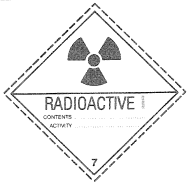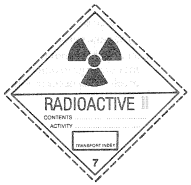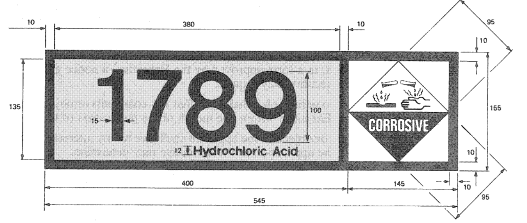- Latest available (Revised)
- Original (As made)
Dangerous Substances in Harbour Areas Regulations (Northern Ireland) 1991
You are here:
- Northern Ireland Statutory Rules
- 1991 No. 509
- Schedules only
More Resources
Status:
This is the original version (as it was originally made). This item of legislation is currently only available in its original format.
Regulations 2(1), 3(1) and (2)
SCHEDULE 1The Classification of and Hazard Warning Signs for Dangerous Substances
PART ITABLE OF CHARACTERISTIC PROPERTIES, CLASSIFICATIONS AND HAZARD WARNING SIGNS
| (1) | (2) | (3) |
|---|---|---|
| Characteristic properties of the substance | Classification | Hazard warning sign |
| ||
A substance which— (a) has a critical temperature below 50°C or which at 50°C has a vapour pressure of more than 3 bar absolute; and (b) is conveyed at a pressure of more than 500 millibar above atmospheric pressure or in liquefied form; other than a toxic gas or a flammable gas. | Class 2 (Non-flammable compressed gas) | 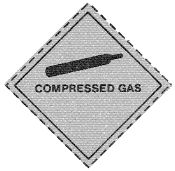 |
| A substance which has a critical temperature below 50°C or which at 50°C has a vapour pressure of more than 3 bar absolute and which is toxic. | Class 2 (Toxic gas) |  |
| A substance which has a critical temperature below 50°C or which at 50°C has a vapour pressure of more than 3 bar absolute and is flammable. (See Note 1). | Class 2 (Flammable gas) |  |
A liquid with a flash point of 55°C or below except a liquid which— (a) has a flash point equal to or more than 2 1°C and less than or equal to 55°C and (b) when tested at 55°C i the manner described in Schedule 2 to the Highly Flammable Liquids and Liquefied Petroleum Gases Regulations (Northern Ireland) 1975(1) doe not support combustion. (See Notes 2 to 4). | Class 3 (Flammable liquid) | 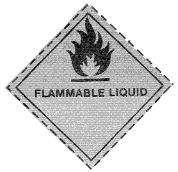 |
| A solid which is readily combustible under condition encountered in a harbour or harbour area or which may cause or contribute to fire through friction. | Class 4.1 (Flammable solid) |  |
| A substance which is liable to spontaneous heating under conditions encountered in a harbour or harbour area or to heating in contact with air being then liable to catch fire | Class 4.2 (Spontaneously combustible substance) |  |
| A substance which in contact with water is liable to become spontaneously combustible or to give off a flammable gas. | Class 4.3 (Substance which in contact with water emits flammable gas) | 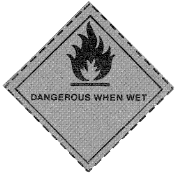 |
| A substance other than an organic peroxide, which, although not itself necessarily combustible, may by yielding oxygen or by a similar process cause or contribute to the combustion of other material. | Class 5.1 (Oxidizing substance) |  |
A substance which is— (a) an organic peroxide; and (b) an unstable substance which may undergo exothermic self-accelerating decomposition. | Class 5.2 Organic peroxide) |  |
| A substance known to be so toxic to man as to afford a hazard to health under conditions encountered in a harbour or harbour area or which, in the absence of adequate data on human toxicity, is presumed to be toxic to man. | Class 6.1 (Toxic substance) |  |
| A substance known to be toxic to man or, in the absence of adequate data on human toxicity, is presumed to be toxic to man but which is unlikely to afford a serious acute hazard to health under conditions encountered in a harbour or harbour area. | Class 6.1 (Harmful substance) | 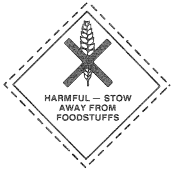 |
| A substance which contains disease-producing microorganisms. | Class 6.2 (Infectious substance) |  |
| A substance of specific activity of more than 70 Becquerels per gram (0.002 microcuries per gram) (See Note 5). | Class 7 (Radioactive substance) | |
A substance which by chemical action will— (a) cause severe damage when in contact with living tissue, or (b) materially damage other freight or equipment if leakage occurs. | Class 8 Corrosive substance) |  |
| Two or more dangerous substances having different classifications. | Multi-load | |
An explosive substance, that is to say— (a) a solid or liquid substance, or (b) a mixture of solid or liquid substances or both, which is capable by chemical reaction in itself of producing gas at such a temperature and pressure and at such a speed as could cause damage to surroundings, including one or more such substances contained in an article and which has a predominant hazard appropriate to another Class but which nevertheless presents a significant hazard from explosion. | According to the predominant hazard | |
PART IISPECIFICATION OF HAZARD WARNING SIGNS
1. The hazard warning sign to be used on a hazard warning panel, on a label to be affixed to a compartmented tank barge or to be affixed to a freight container, portable tank or receptacle shall be that shown in column 3 of Part I for the classification of the substance shown in the corresponding entry in column 2, and the signs shall conform in form and colour to those shown in column 3, except that—
(a)in the case of the signs for the classifications “non-flammable compressed gas”, “flammable gas”, “flammable liquid” and “substance which in contact with water emits flammable gas”, the symbol and lettering may be in white;
(b)in the case of the sign for the classification “spontaneously combustible substance”, the lettering may be in white;
(c)in the case of the signs for the classifications “oxidizing substance” and “organic peroxide”, the part of the symbol showing the flame may be completely in black;
(d)in place of the word “toxic”, the word “poison” may be used wherever it occurs;
(e)in place of the word “flammable”, the word “inflammable” may be used
(f)the sign may show ;he class number in accordance with the IMDG Code and in the case of Class 7 must show the Class number.
2. Each hazard warning sign shall be in the form of a square set with its sides at an angle of 45° to the vertical and the length of the sides shall be—
(a)in the case of signs on hazard warning panels, not less than 200 millimetres;
(b)in the case of signs on the labels for compartmented tank barges, not less than 95 millimetres;
(c)in the case of signs, other than those for substances in Class 7, to be affixed to a freight container, portable tank or receptacle, not less than 100 millimetres. except that, in the case of receptacles that are of such dimensions that they can only bear smaller signs, the sign should be as large as is reasonably practicable;
(d)in the case of signs for substances in Class 7 to be affixed to a freight container, portable tank or receptacle, 100 millimetres.
3. Hazard warning signs to be affixed to a freight container, portable tank or receptacle shall have a line of the same colour as the symbol, 5 millimetres inside the edge and running parallel to it. (The broken line which surrounds each sign delineates the edge of that sign and need not be shown.)
4. Hazard warning signs to be affixed to hazard warning panels and labels for compartmented tank barges, shall for any part of the sign that is not black have a black border—
(a)in the case of signs for hazard warning panels, at least 2 millimetres wide;
(b)in the case of signs for labels, at least 1 millimetre wide.
Regulation 3(4)
SCHEDULE 2Examples of Substances and Articles not to be treated as being in Class 4.2
(Spontaneously combustible substance)
1. Rubber scrap and rubber shoddy, in powdered or granulated form
2. Copra.
3. Cotton waste, oily
4. Cotton, wet.
5. Fibres, animal or vegetable, burnt. wet or damp
6. Fibres or fabrics, animal or vegetable, with animal or vegetable oil
7. Fish meal (unstabilised).
8. Iron oxide, spent, or iron sponge. spent (obtained from coal gas purification).
9. Paper, treated with unsaturated oils, incompletely dried (includes carbon paper).
10. Seed cakes (seed expellers) containing more than 1.5% oil and not more than 11% moisture.
11. Wool waste, wet.
12. Rags, oily.
13. Textile waste, wet
14. Seed cakes, containing not more than 1.5% oil and not more than 11% moisture.
Regulations 8(1) and 15(1)
SCHEDULE 3List of specified dangerous substances
The dangerous substances referred to in regulations 8(1) and 15( 1) are—
(a)more than 25 tonnes of sodium chlorate or potassium chlorate. or more than 500 tonnes of ammonium nitrate of Class 5.1;
(b)bulk liquefied gases of Class 2, including the remnants of such gases which, remain after their discharge from a tank which has not subsequently been gas-freed or inerted;
(c)bulk liquids of Class 3 with a flashpoint, when determined in accordance with one of the methods described in Part IV of Schedule 1 to the Classification, Packaging and Labelling of Dangerous Substances Regulations (Northern Ireland) 1985, not exceeding 60"C, including the remnants of such liquids which remain after their discharge from a tank which has not subsequently been gas-freed or inerted.
(d)bulk liquids of Classes 4, 5, 6.1 and 8 of UN Packing Groups I and II in the UN list;
(e)bulk liquids of Class 6.1, UN Packing Group III in the UN list. if such liquids have a harmful inhalation risk.
Regulation 8(1)
SCHEDULE 4Flag indicating that a vessel is carrying a dangerous substance
PART ISHAPE AND COLOUR OF FLAG
1. The shape of the flag shall be as shown in the diagram below.
2. The flag shall be red in colour.
PART IIMATERIAL AND SIZE OF FLAG ON VESSELS WITH A MAST
1. The flag shall be made of fabric.
2. The side of the flag marked “a” on the diagram shown in Part I shall be not less than 75 centimetres in length and the sides of the flag marked “b” on the said diagram shall have equal lengths of not less than 90 centimetres.
PART IIIMATERIAL AND SIZE OF FLAG ON VESSELS WITHOUT A MAST
1. The flag shall be made of metal.
2. The side of the flag marked “a” on the diagram shown in Part 1 shall be not less than 45 centimetres in length and the sides of the flag marked “b” on the said diagram shall have equal lengths of not less than 54 centimetres.
Regulations 2(1) and 11
SCHEDULE 5Hazard Warning Panels
Form and colour of hazard warning panels
1. Each hazard warning panel shall be in the form and colour of the following diagram—
2. Any reference in paragraph 3 to a space number is a reference to the space so numbered in the diagram in paragraph 1.
Information about substances on a barge or tank barge
3. The following information shall be shown on each hazard warning panel when a barge or tank barge is carrying a dangerous substance—
(a)in space (1)—
(i)where only one substance is being carried and that substance is specified in the approved list or the UN list, the substance identification number for that substance, except that the chemical name, an accepted common name or the trade name of the substance may also be included;
(ii)where only one substance is being carried and that substance is not specified in the approved list or the UN list, the chemical name, an accepted common name or the trade name of the substance;
(iii)where more than one dangerous substance is being carried, the word “Multi-load”; and
(b)in space (2)—
(i)where only one dangerous substance is being carried and that substance is specified in the approved list or the UN list, the hazard warning sign for the classification of that substance;
(ii)where only one dangerous substance is being carried and that substance is not specified in the approved list or the UN list, the hazard warning sign specified in column 3 of Part 1 of Schedule 1 for the most hazardous of the characteristic properties of the substance;
(iii)where more than one dangerous substance is being carried and all of those substances are of the same classification, the hazard warning sign for that classification specified in column 3 of Part I of Schedule 1;
(iv)where more than one dangerous substance is being carried and all of those substances are not of the same classification, the hazard warning sign for multi-load specified in column 3 of Part I of Schedule 1;
(c)in space (3), the telephone number at which or by means of which specialist advice can be obtained at all times when the substance is being carried; and
(d)in space (4), the name of the manufacturer or owner of the substance, his house symbol, or both, may be shown but otherwise the space shall be left blank.
Specification for hazard warning panels
4. The specifications for hazard warning panels shall be those set out in the diagrams below with dimensions in millimetres; larger measurements may be used, but in that case they shall be kept in the same proportions to each other except that the lettering and figures may remain as shown in the diagram, or be of intermediate size. The diagonal lines in the top left may be thinner and may slope in the opposite direction.
For single loads—
For multi-loads-300
Labels for compartmented tank barges
Form of labels
5. In the case of a tank barge which has separate tanks which are being used to carry different dangerous substances at the same time the label to be attached to each tank in accordance with regulation 1 l(2) shall be in the form and colour of the following diagram except that where all the dangerous substances being carried are of the same classification, space (2) may be omitted.
6. Any reference to a space number in paragraphs 5 and 7 is a reference to the space so numbered in the diagram in paragraph 5.
Information to be shown on labels
7. The following information shall be shown on each label—
(a)in space (1)—
(i)where the substance is specified in the approved list or the UN list, the substance identification number of that substance, except that the chemical name. an accepted common name or the trade name of the substance may also be included, or
(ii)where the substance is not specified in the approved list or the UN list, the chemical name, an accepted common name or the trade name of the substance;
(b)in space (Z)—
(i)where the substance is specified in the approved list or the UN list, the hazard warning sign for the classification of that substance,
(ii)where the substance is not specified in the approved list or the UN list, the hazard warning sign specified in column 3 of Part I of Schedule 1 of the most hazardous of the characteristic properties of the substance;
(c)where all the substances being carried have the same classification. space (2). if included in the label, may be left blank.
Specification for labels
8. The specification for labels is set out below with dimensions in millimetres; larger measurements may be used but in that case they shall be kept in the same proportions to each other except that the lettering and figures may remain as shown in the diagram or be of intermediate size.
Colour of hazard warning panels and labels
9. Where in this Schedule parts of hazard warning panels are shown as coloured orange that colour shall match the colour in the British Standard Specification BSS No. 381C (1980) No. 557 Light Orange.
Regulation 33(1)
SCHEDULE 6Provisions relating to Bye-laws
1. In this Schedule, “bye-laws” means bye-laws made by a district council for all or any of the purposes set out in regulation 33(1).
2. Bye-laws shall be made under the common seal of the district council and shall not have effect until they are confirmed by the Department of the Environment; Provided that a bye-law which prohibits or regulates the entry of a dangerous substance into a harbour area and which has been made after consultation with any berth operator who appears to the district council to be affected by the proposed bye-law, shall come into operation when application is made for its confirmation but such a bye-law shall cease to have effect if the Department of the Environment refuses to confirm the bye-law or, if it confirms the bye-law with modifications, shall thereafter have effect as so modified.
3. At least one month before application for confirmation of the bye-laws is made, notice of the intention to apply for confirmation shall be given in two or more local newspapers circulating in the vicinity of the harbour area to which the bye-laws are to apply.
4. For at least one month before application for confirmation is made, a copy of the bye-laws shall be deposited at the offices of the district council by whom the bye-laws are made and shall at all reasonable hours be open to public inspection without payment.
5. The Department of the Environment may confirm, with or without modifications, or refuse to confirm, any bye-law submitted for confirmation, and subject to the proviso in paragraph 2 may fix the date on which the bye-law is to come into operation and subject as aforesaid if no date is fixed the bye-law shall come into operation at the expiration of one month from the date of its confirmation;
Provided that where the Department of the Environment proposes to confirm a bye-law with a modification which appears to it to be substantial it shall inform the district council and require the district council to take any steps it considers necessary for informing persons likely to be concerned with the modification and shall not confirm the bye-law until such period has elapsed as it thinks reasonable for consideration of, and comment upon, the proposed modification by the district council and by other persons who have been informed of the modification.
6. The Department of the Environment shall not under the foregoing provisions confirm, whether or not with modifications, or refuse to confirm, a bye-law except after consultation with the Department.
7. A copy of the bye-laws, when confirmed, shall be printed and shall be deposited at the offices of the district council by whom the bye-laws are made, and shall at all reasonable hours be open to public inspection without payment.
Regulation 37(1) and (2)
SCHEDULE 7Repeals, Revocations and Savings
PART IPETROLEUM BYE-LAWS REPEALED
| (1) | (2) |
|---|---|
| Title of Bye-laws | Extent of Repeal |
| Belfast Harbour Commissioners Petroleum Spirit and Carbide of Calcium Bye-laws 1962 | The whole Bye-laws |
| Carrickfergus Urban District Council Petroleum Spirit and Carbide of Calcium Bye-laws 1937 | The whole Bye-laws |
| Larne Harbour Limited Petroleum Spirit and Carbide of Calcium Bye-laws 1934 | The whole Bye-laws |
| Londonderry Port and Harbour Commissioners Petroleum Spirit and Carbide of Calcium Bye-laws 1953 | The whole Bye-laws |
PART IIOTHER REGULATIONS AND HARBOUR BYE-LAWS REPEALED
| (1) | (2) |
|---|---|
| Title of Regulations or Bye-laws | Extent of Repeal |
| Belfast Harbour Commissioners Regulations Relative to Dangerous Goods at Belfast Harbour 1960 | The whole Regulations |
| Londonderry Port and Harbour Commissioners General Bye-laws 1926 | The whole Bye-laws |
| Portrush Harbour Company General Bye-laws 1865 | The whole Bye-laws |
Options/Help
Print Options
PrintThe Whole Rule
PrintThe Schedules only
Legislation is available in different versions:
Latest Available (revised):The latest available updated version of the legislation incorporating changes made by subsequent legislation and applied by our editorial team. Changes we have not yet applied to the text, can be found in the ‘Changes to Legislation’ area.
Original (As Enacted or Made): The original version of the legislation as it stood when it was enacted or made. No changes have been applied to the text.
More Resources
Access essential accompanying documents and information for this legislation item from this tab. Dependent on the legislation item being viewed this may include:
- the original print PDF of the as enacted version that was used for the print copy
- lists of changes made by and/or affecting this legislation item
- confers power and blanket amendment details
- all formats of all associated documents
- correction slips
- links to related legislation and further information resources
More Resources
Use this menu to access essential accompanying documents and information for this legislation item. Dependent on the legislation item being viewed this may include:
- the original print PDF of the as made version that was used for the print copy
- correction slips
Click 'View More' or select 'More Resources' tab for additional information including:
- lists of changes made by and/or affecting this legislation item
- confers power and blanket amendment details
- all formats of all associated documents
- links to related legislation and further information resources
